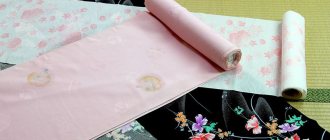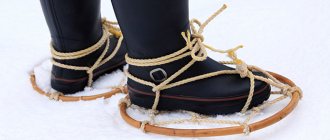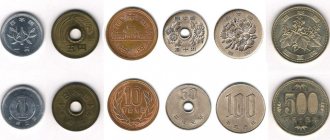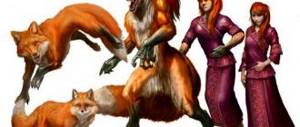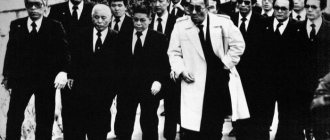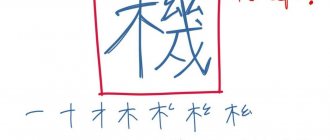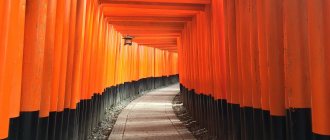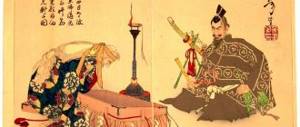Japanese and European classification of edged weapons are very different. According to the latter, the famous Japanese katana sword is not a sword at all, but a saber with a curved blade and one-sided sharpening. The Japanese consider any type of bladed weapon with a blade length of more than 15 cm, a line of rigidity and a shank with a hole for a special spike to be a sword. A very wide range of bladed weapons falls into this category, from the short tanto dagger to such giants as the naginata, with a length often exceeding two meters.
The naginata is often called the Japanese halberd and is classified as a pole weapon. Both are wrong. In its functions and combat use, the naginata is more similar to the European glaive, although they are very different in design. In Japanese, the name of this weapon is written using two hieroglyphs, the first of which denotes the shaft, and the second - the curved sword. Literally this word is translated as “long sword” or “sword on a shaft.”
A naginata is a bladed weapon that consists of a long handle (up to two meters) and a curved blade with a one-sided sharpening. Its dimensions can reach 30 cm. Moreover, it should be noted that the wooden part of the weapon is not a shaft, as in the case of a glaive, but a handle with an oval cross-section. This form greatly facilitated fencing, allowing it to parry even the fastest blows from a sword or spear.
The naginata blade is attached to the hilt in the same way as similar elements on shorter swords. In shape it also strongly resembles the blade of an ordinary Japanese short sword. It is separated from the handle by a ring-shaped guard, sometimes supplemented by a metal crossbar, bent upward or straight. These elements were used to parry enemy attacks.
At the lower end of the handle, an “ishizuki” was usually attached - a special metal cap (often pointed) that served as a counterweight to the blade, and it could also be used to strike.
Shortened versions of this weapon with a handle up to 1.5 meters are known. They were usually used during training, or such mini-naginatas were made for women. We can also add that the size and appearance of the naginata depended on the taste of the owner of the weapon and his individual characteristics: height, physical strength, arm length, etc.
The technique of wielding this weapon is called naginatajutsu, and it is almost older than the art of wielding a traditional Japanese sword. The first mention of the combat use of the naginata can be found in the Kojiki chronicle, it dates back to 712. Researchers studying the history of Japanese martial arts claim that there were more than 400 schools in the country that taught naginatajutsu.
However, the most interesting thing is something else: despite its considerable size, the naginata sword was and still remains the most “feminine” type of Japanese edged weapon.
Use in combat
The main factor in combat flails is the speed with which the blow is struck, therefore the striking technique used in battles implied a wrist blow with a short swing or without one at all.
The blow itself had to hit the enemy's head or body; it was even possible to hit his unprotected back (due to the presence of a rather long chain). This was due to the fact that the flail is a weapon of the first strike, and it was almost impossible to defend with it.
Even with a metal flail handle, it was almost impossible to repel a blow (no matter what weapon) due to the unpredictable behavior of this handle and the load. It’s beautifully shown in films that with a flail or just a chain you can take away a sword or pike from an enemy
In practice, everything is not so clear. You can get injured from your own flail
The films beautifully show that with a flail or just a chain you can take away a sword or pike from an enemy. In practice, everything is not so clear. You can get wounded by your own flail.
Light cavalrymen successfully used the flail as an additional weapon in the lands of Ancient Rus'. This is due to the difference in the history of Europe and the eastern part of Ancient Rus', to which the era of chivalry did not reach.
In Europe, in the Middle Ages, heavily armed knights on the battlefield, who relied on the force of the blow, and not on its speed, used the flail extremely rarely. Heavy ammunition did not allow for a quick wrist strike, and the weapon itself was considered a weapon of commoners.
The use of this weapon by knights was recorded only in cases when in battle he was deprived of his more familiar weapons - a sword, spear, battle axe, and this applies to the morning star, and not to the flail.
On the other hand, having a saber and a flail technique proven in battle, a lightly armed warrior penetrated the defense of a heavily armed shield-bearer. The low cost of production made it possible to easily and in a short time arm an army of rebel peasants or conscripted militias, since their weapons were non-combatant.
It should be remembered what the Hussite camp was like - these were war carts placed in a circle, behind which the army was hiding.
When the enemy tried to break into the camp, each of the defenders had time for one blow. The Czech peasants with these weapons (which by that time had become similar to a morning star) were able to successfully go on the attack, literally mowing down a number of enemy soldiers at the first blow.
With the development of technology, edged weapons were increasingly replaced by firearms. This trend did not bypass flails, although their last use in battle was recorded during the First World War. But this was the improvisation of individual soldiers, and not generally accepted army practice.
Design features
Japanese polearms have one peculiarity. Almost all of it is petiolate and not sleeved. That is, it is attached to the handle not by a sleeve or eye into which the shaft is threaded, but by a long tang, which is driven into the shaft and secured there in exactly the same way as the tang of a sword.
Therefore, it is more correct to call the naginata shaft a hilt or even a hilt, no matter how strange it may seem to us.
But European halberds, glaives, axes, reeds and guisarms - all of them, without exception, are either socketed or eyed. They do not have any shanks going into the shaft. That's it.
Only the oldest example of naginata, the tsukushi naginata, had an eyelet. Such weapons existed in Japan in the tenth century. Later it was abandoned and naginatas began to be made according to the same principle as swords.
Tsukushi naginata
Why is this so, since the eye fastening is much stronger than the traditional Japanese stem fastening? Nobody knows, but the Japanese abandoned the eye mounting. Nakago shank
The classic naginata is secured in the shaft with a single bamboo mekugi pin, like the tang of a tachi or katana in the handle.
Naginata Blade
A halberd is a combined weapon: an axe, a spear and a hook rolled into one. The naginata never had any sharp spikes or hooks; it was a sword-shaped blade on a shaft - and nothing more.
Naginata today
Now the naginata is one of the symbols of Japan. Yes, it is not as famous as the katana, but it also regularly appears in modern culture (cinema, anime, etc.). Similar weapons are very easy to find in museums, and some of the exhibits can boast of a glorious history stretching back centuries.
In the homeland of weapons, you can still learn how to use them. In addition to specialized schools, there are also thematic courses in some general education institutions. Not only boys, but also girls master the art of naginata.
There is also an International Naginata Federation with branches in Russia, the USA and a number of other countries. Now this is another martial art with two varieties: a duel and a demonstration of weapons technique. If you ever have the opportunity to attend a competition like this, be sure to do so.
Japanese weapon Naginata (Naginata) one of the rare varieties - Tsukushi Naginata
Shield on the sword handle
According to the European classification, this is a polearm Halberd with its type resembling a reed in shape. Tsukushi Naginata is the original form of Naginata, its oldest form in Japan. Apparently, the ancestor of this rare type of blade was Nata (mountain sword), namely nata () used for cutting off twigs and shoots at a considerable height. In modern Japan, similar agricultural implements are still used. We could not help but mention such a rare form as Hozu hi yari
The Sukishi (Tsukishi) Naginata was used by samurai in battle from the end of the Heian period (1185) to the Muromami period. A special feature of the attachment to the shaft was two, and sometimes three rings located on the shank of the blade (the shank was not inserted into the shaft like a naginata: Japanese antique pole weapon Ko-Naginata Kakure). Blade structure Not many examples of tsukushi-nagin have survived to this day, partly due to the long history of its use; an unfortunate fact for historians and collectors of our time is the fact that over many centuries, generations of samurai, having not found a logical use for this unique weapon, reforged blades and adjusted, so to speak, to the circumstances, i.e. received a naginata or a wakizashi sword.
We https://antikvariat-japan.ru/ have more than once posted videos on our YouTube channel mentioning rare forms of blades of Japanese samurai polearms.
Flail
The contact-crushing device was widely valued in horse battles, when the enemy forces were dominant. Flail - a club on which there is a chain with a ball. The force of the blow was so great that the strongest armor was crushed and the enemy flew out of the saddle. The weapon was intended not only to kill, but also to disorient the enemy.
Origin story
The first maces appeared during the times of Rus'. The weapon had high striking power, but the lack of mobility and agility reduced its overall effectiveness. This shortcoming was noticed by European gunsmiths and at the end of the 10th century the first flail was born.
Weapons quickly gained relevance. The foot soldiers knocked out the horsemen, while being out of range of the swords. Weights on a chain began to be used by English knights, German and Italian horsemen. Heavily armed mounted infantry were placed in the front ranks to introduce discord and disorder into the enemy ranks.
The final modernization took place only in the 14th century. Long spikes appeared on the weight, the chain and club became longer. But there are fewer soldiers who can handle weapons due to their increased weight. Training began for warriors who knew exclusively the chain weight and techniques that allowed it to be used as efficiently as possible.
Description
The design of the flail implies mobility, agility and high striking power. The initial type of weapon was a club with a comfortable handle (50 centimeters) called a flail. At the other end there is a ball (weight) of different sizes and shapes. The fastening element is a strong iron chain, half a meter long.
During active hostilities, the flail was significantly modified. The fist was lengthened to 70 centimeters, the ball became larger and equipped with spikes. The iron chain was thickened, but its length remained the same.
Lengthening the mounting structure reduced mobility, since the warrior needed more effort to throw the flail at the enemy.
Varieties
In a combat situation, the only correct decision is adaptation to current events. An incorrectly selected weapon cost a warrior his life. The flail was effective only in close combat; it was useless against a spear or two-handed sword. To compensate for the shortcomings of weapons, several types were invented, intended for combat against infantry or cavalry:
- Standard type. Has its original appearance. Effective against mounted infantry and close combat. There were no spikes on the ball; the total diameter of the weight was 15-20 centimeters. It was impossible to inflict mortal damage on the enemy;
- The next type is contact-crushing weapons. It did not differ from the standard flail in design, but the weight was significantly modified. Spikes appeared, and the impact structure began to be made in a rhombic or square shape. Easily pierced weak armor;
- Morgenstern is the finished form of this weapon. Handle length – 60 centimeters. The Morgenstern was equipped with a special strap for convenient placement on the hand. Long spikes or small protrusions appeared on the weight. There is an opportunity to inflict a mortal wound on the enemy.
The flail is effective against infantry or horsemen wearing light armor. Even the morning star could not penetrate the strong armor. Modern interpretations of this weapon are intended only to stun and disorient the enemy.
History of weapons
The first mention of the naginata dates back to the 12th century, but there is reason to believe that the weapon was created much earlier. Some historians even believe that the naginata came to Japan from China and was adapted to local realities. Unfortunately, we will never know the truth - too much water has flown under the bridge since those distant times.
Initially, this weapon was used mainly by sohei (war monks), but it quickly gained popularity. It's all about the increased efficiency achieved through multiple use cases and the ability to engage in long-range combat. In particular, naginatas were very effective against cavalry, as they allowed them to hit horses and throw riders to the ground.
It was because of the naginata that one important change appeared in the Japanese armor - leg protection was added. Special pads on the shins and thighs were designed to protect the soldiers from its sharp blade.
The naginata's popularity began to wane in the 14th and 15th centuries. Due to changes in military affairs, dense ranks of spearmen with shields began to appear more and more often on the battlefields. The weapons were not effective enough against such warriors.
In the 17th century, the first guns and pistols appeared. After this, only the most notorious retrogrades continued to use the naginata in battle. Even ardent adherents of edged weapons chose other, more compact solutions.
TRIDENT
Trident
It is considered the most mythical weapon. It was customary to represent the two most important Roman gods with him: Jupiter and Poseidon. It was also considered a weapon for gladiator combat. It was used in fights reaching the highest cruelty.
At one time among such peoples as the Persians, and at another among the Turks and Huns, Slavs, Indians, and Germans, it was a weapon that seemed to them to give powerful advantages. In Ukraine and Mongolia, to this day it is possible to notice illustrations of the trident in various state paraphernalia.
The trident is a more developed type of spear connected to a hook. Initially it was a fishing tackle, with a blade. They slaughtered fish or various sea creatures with it.
The trident is a type of weapon used in Chinese martial arts.
Ji (analogous to a trident) dates back to the eleventh century. Allows you to perform many different techniques. The assembly mechanism allows the blade to inflict lacerations, significantly weakening the enemy. Also, with the correct use of a trident, it is possible to disarm an enemy by delivering blows that damage his hand. It also found echoes in the Hinduism and Buddhism religions. Used by their gods for protective and destructive properties.
It is also noted as the weapon of the devil among Christians of our time.
We are Asians
But let's move on to practice. So, the lesson begins. We are given training naginatas - they differ from real combat ones in that the blades are not steel, but made of bamboo. I estimate the weight of the weapon - a little lighter than its European counterparts, but it makes a strong impression. Daria shows the main stances - there are more of them here than in bayonet fighting, which is somewhat similar to naginata-do. The biggest difference is that in Europe it is customary to face the enemy with only your left or right shoulder during a fight (depending on the fighting school), but in naginata you can change the position, choose one that is more convenient for yourself and less convenient for the enemy.
Next, the practice of strikes and defenses begins. The weapon is long, so it allows you to hit the enemy in almost all sectors - in the head, body, and legs. This means that everything has to be protected at once. Again, not only the blade, but also the hilt of the naginata is used for protection - something that is almost impossible to see in European schools.
After independent practice, work in pairs begins. My partner and I take turns striking each other - in a strictly defined sequence to prevent injury. This is an important stage, because this is how basic skills are consolidated - how to react to enemy attacks, so as not to think about it in a fight, but to do everything automatically. Anyone who has practiced fencing or martial arts knows that in battle you don’t have time to think about defense, the body itself must react correctly.
This kind of work takes quite a lot of time. My arms, legs and body were already pretty tired from the unusual movements. But, when the lesson is nearing the end, I can’t resist asking Daria for sparring. She agrees, we go to put on armor. Which are worth mentioning in particular. Those who have practiced kendo (or at least know it from movies) can imagine what this armor looks like - it looks like medieval samurai armor. The hard “do” breastplate, “kote” hand guards, “tare” belt and “men” helmet protect the fighter even from the most powerful blow of the enemy. Those who practice seriously also have a pouch on their waist with the name and name of the club - of course, I’m not allowed to have that yet.
So we put on our armor and, at Daria’s command, we converge. I admit, it was very difficult. My naginata skill level is zero, it’s almost impossible to compete with an experienced fighter. And it’s unusual to move in such armor. It's not that they are uncomfortable - quite the opposite. But still, as an adept of classical European fencing, I am accustomed to others. Plus, the constant change of enemy stances is confusing. And while I realized that I myself could use this to my advantage, I missed a lot of offensive blows.
But perhaps the most difficult thing was different. I repeat, I am more accustomed to European fencing. And there it is accepted that after a blow or a thrust reaches the enemy, the fight is suspended. The judges announce who has earned points, and the fencers prepare to continue. This is not the case with the Japanese - even if you hit the enemy, the fight does not end. And you can immediately get a few more hits. Which is highly welcome, as it demonstrates fighting spirit. To be honest, I was never able to overcome this barrier until the end of the sparring.
But all good things come to an end. We greet each other with a traditional bow, and I go to take off my equipment. And I finally realize that I have become acquainted with an original discipline - I have never tried anything like it before.
Naginata fencing perfectly develops reaction, the ability to quickly make the right decision, calculate forces and determine the right moment for a jerk. And, of course, it gives you the opportunity to feel like, albeit briefly, a medieval Japanese samurai.
Alexey Butsaylo
All articles by the author
31 March 2021, 14:16
894
The art of using the naginata
The Naginata is an extremely versatile weapon. Its owner can inflict piercing and cutting blows on opponents, as well as place effective blocks. It is not surprising that in different regions of Japan there were their own schools that taught naginata.
And it all started with general physical training. If a person does not have developed forearms and hands, he will very quickly get tired of wielding a naginata, after which it will turn out to be useless in a real confrontation.
Another feature of all naginata fighting techniques is weapon juggling. Constantly throwing from hand to hand, spinning, deceptive blows - all this allows you to intimidate and confuse the enemy. In the hands of a skilled master, it is capable of defeating even the most experienced and attentive warrior.
Free Jasper Dew cocktail
But the most insidious invisible weapon, of course, remained poisons. Mochizuki Chieme knew the secrets of more than 300 potions of various properties: medicinal and tonic, relaxing and stimulating, intoxicating and stimulating, and, of course, poisons and antidotes. If a slow-acting poison was required, tea was brewed with the poetic name “Gekuro” - jasper dew.
Premium quality Gyokuro tea
It was poured into a bamboo vessel and buried for forty days to rot. The resulting black pulp, 2-3 drops per day, was mixed into food. A healthy person fell ill after 10 days, died after 70, the weak died earlier, and not a single doctor could determine the cause of death. Zagarashiyaku, poisons that kill on the spot, were also readily used. For example, boil the seeds of unripe plums and peach in equal parts, boiled together for a long time. If you want - for food, if you want - spray it in the air. There is only one outcome.
“Blood” poisons were used to lubricate arrows, needles and “death stars” - shuriken. It was possible to roast the giant Japanese toad “hikigaeru” with a 22-centimeter body on a spit. The poison will flow out of the glands, ferment - and the victim will be paralyzed.
There were a lot of sedatives. “If you dry hemp in the shade and grind it into flour, then boil it, add it to tea: one sip will make you fall asleep, two or three will cause a feverish sleep with fever, and after a few days of such a treat you will go crazy.” This is what a recipe from an ancient treatise looks like.
WAR HAMMERS
Heavy War Hammer
Initially they found their use in Persia, India, and Germany. Over time, they found use throughout Europe. It has a shock-crushing effect. Used mainly against chain mail and armor. Due to its bulkiness, it also had a stunning effect.
It was also loved by the common people due to its cheapness. It was actively used during the 1932 uprising in Paris.
The emergence of the first types of hammers used in battle became possible with an increase in the length of the handle and modernization of the warhead.
This type of weapon was effective in combat when attacking, as it had high combat properties and a stunning effect. However, when defending, it became completely useless. A fighter who used a hammer as a weapon had to combine it with a shield or armor.
Over time, having modernized it, it became possible to get stuck in enemy armor, thanks to the use of a pointed tip. This modernized hammer was called klevets. The possibility of getting stuck in armor moved such a hammer into the category of additional weapons.
Klevets could often be confused with coinage, although each of them is a modernization of a separate type of weapon. There was also an option to combine the klevts and the mint. This modernized look was found in China. This weapon had a unique name. Chariot warriors used it to strike prone targets and capture the enemy.
How it was made
The structural features of the naginata are reflected in the photo: the object reaches two meters, has a one-sided sharpened blade about 30 cm long. The peculiarity of the handle is an oval cross-section. The blade is preceded by a guard ring, improved by a metal crossbar. Due to the cross-section of the handle and guard, the weapon acts quickly and is convenient in parrying an enemy attack.
The end of the handle of the Japanese sword was supplemented with ishizuki - a pointed counterweight, an additional striking element.
Ancient painting: samurai with naginata
Excerpt characterizing Kusarigama
The command of the left flank belonged by seniority to the regimental commander of the very regiment that was represented at Braunau by Kutuzov and in which Dolokhov served as a soldier. The command of the extreme left flank was assigned to the commander of the Pavlograd regiment, where Rostov served, as a result of which a misunderstanding occurred. Both commanders were very irritated against each other, and while things had been going on on the right flank for a long time and the French had already begun their offensive, both commanders were busy in negotiations that were intended to insult each other. The regiments, both cavalry and infantry, were very little prepared for the upcoming task. The people of the regiments, from soldier to general, did not expect battle and calmly went about peaceful affairs: feeding horses in the cavalry, collecting firewood in the infantry. “He is, however, older than me in rank,” said the German, a hussar colonel, blushing and turning to the adjutant who had arrived, “then leave him to do as he wants.” I cannot sacrifice my hussars. Trumpeter! Play retreat! But things were getting to a point in a hurry. The cannonade and shooting, merging, thundered on the right and in the center, and the French hoods of the Lannes riflemen had already passed the mill dam and lined up on this side in two rifle shots. The infantry colonel walked up to the horse with a trembling gait and, climbing onto it and becoming very straight and tall, rode to the Pavlograd commander. The regimental commanders gathered with polite bows and with hidden malice in their hearts. “Again, Colonel,” said the general, “I cannot, however, leave half the people in the forest.” “I ask you, I ask you,” he repeated, “to take a position and prepare to attack. “And I ask you not to interfere, it’s not your business,” the colonel answered, getting excited. “If you were a cavalryman...” “I’m not a cavalryman, colonel, but I am a Russian general, and if you don’t know this...” “Very well known, Your Excellency,” the colonel suddenly cried out, touching the horse, and turning red and purple. “Would you like to put me in chains, and you will see that this position is worthless?” I don't want to destroy my regiment for your pleasure. - You are forgetting yourself, Colonel. I do not respect my pleasure and will not allow anyone to say this. The general, accepting the colonel's invitation to the tournament of courage, straightened his chest and frowned, rode with him towards the chain, as if all their disagreement was to be resolved there, in the chain, under the bullets. They arrived in a chain, several bullets flew over them, and they stopped silently. There was nothing to see in the chain, since even from the place where they had previously stood, it was clear that it was impossible for the cavalry to operate in the bushes and ravines, and that the French were going around the left wing. The general and the colonel looked sternly and significantly, like two roosters preparing for battle, at each other, waiting in vain for signs of cowardice. Both passed the exam. Since there was nothing to say, and neither one nor the other wanted to give the other a reason to say that he was the first to escape from the bullets, they would have stood there for a long time, mutually testing their courage, if at that time in the forest, almost behind them, there had not been the crackle of guns and a dull merging cry were heard. The French attacked soldiers who were in the forest with firewood. The hussars could no longer retreat along with the infantry. They were cut off from the retreat to the left by a French chain. Now, no matter how inconvenient the terrain was, it was necessary to attack in order to pave a path for ourselves.
All photographs in our articles about Japan are from my personal collection.
This article is the property of the Internet project Japanese Antiques (https://antikvariat-japan.ru).
We express only a personal opinion about the Japanese Naginata polearm, based on many years of experience, assistance in selecting collections and communication with the original source, so to speak - the keepers of the history of this ancient country of Nippon. Over the long period of living in this country, we were able to meet a considerable number of respected people, albeit already in old age, among whom, fortunately, there were quite a few people who were fanatically devoted to their country, who loved and appreciated the history of their country and were well versed in martial arts . About some of them, of course, with their permission, we dared to write small articles on this site.
All Naginata swords presented on the site are exclusively original, brought from Japan. All Japanese bladed weapons (Japanese Naginata) are real antique items from Japanese auctions. Please contact us with any questions about antique items presented on this site, we will advise you, and for more detailed information, we will call you.
Not just a woman's business
First, let’s talk about what a naginata is. It is not entirely correct to call it a halberd (although this is a common definition). If we compare it with medieval European weapons, then it is more like a glaive. The Japanese themselves consider the naginata to be a sword, only with a long handle. And specifically with a handle - they argue that in this case the word “shaft” is incorrect to use. There is no point in trying to understand why this is so. Japan is just a mysterious country.
Before coming to class, I generally thought that the naginata was a woman’s weapon. Apparently, this idea was formed under the influence of medieval Japanese prints, which often depict samurai women deftly wielding it. But, as Daria Litunenko, president of the Interregional Naginata Association, told me at the beginning of the training, initially it was men who owned these weapons. First, poor infantrymen, and then noble samurai, who appreciated the advantages of fencing at a great distance from the enemy. The naginata was also considered the favorite weapon of warrior monks, who, unlike their European counterparts, took an active part in local internecine wars.
Of course, in the twentieth century, when firearms became widespread on the islands of the Japanese archipelago, the naginata lost its position and went into the shadows. And it actually came out of there only after World War II, when the Japanese began to revive their classical martial arts. Since then, naginata has been taught on the islands in many educational institutions. True, more like a physical training course, and not as an art of combat. And, of course, all over the world lovers of Japanese exoticism could not help but notice such a martial arts. Including in Russia.
Katanas
Ninja Blade
Characteristics:
- Weight (in kilograms): 1
- Cutting damage: 1.76
- Blunt Damage: 0
- Attack Bonus: +2
- Defense Bonus: -4
- Cost (upon purchase): 75,547
- Cost (on sale): 11,332
Location: Can be picked up from Dimak, who lives in the Ninja Tower.
Katana
Characteristics:
- Weight (in kilograms): 2
- Cutting damage: 2.2
- Blunt Damage: 0
- Attack Bonus: +4
- Defense Bonus: -4
- Cost (upon purchase): 188,870
- Cost (on sale): 28,330
Location: Can be picked up from Emperor Tengu, who lives in a city called Cargo.
Katana without tsuba
Characteristics:
- Weight (in kilograms): 1
- Cutting damage: 2.2
- Blunt Damage: 0
- Attack Bonus: +6
- Defense Bonus: -6
- Cost (upon purchase): 188,870
- Cost (on sale): 28,330
Location: Can be picked up from General Jan in Ash Dome III.
Wakizashi
Characteristics:
- Weight (in kilograms): 1
- Cutting Damage: 1.98
- Blunt Damage: 0
- Attack Bonus: +2
- Defense Bonus: -2
- Cost (upon purchase): 94,435
- Cost (on sale): 14,165
Location:
- Can be picked up from Lady Kana, who lives in Port North.
- Can be picked up from Mistress Grace, who lives in the Southern Slave Farm.
- Can be picked up from Mistress Ren, who lives in the Slave Farm located in the Heng region.
Topper
Characteristics:
- Weight (in kilograms): 4
- Cutting damage: 2.42
- Bludgeon Damage: 0.2
- Attack Bonus: 0
- Defense Bonus: 0
- Cost (upon purchase): 56,660
- Cost (on sale): 8,499
Location: Can be picked up from the Rhino found in Ash Dome II.
Nodachi
Characteristics:
- Weight (in kilograms): 8
- Cutting damage: 2.64
- Blunt Damage: 0
- Attack Bonus: +4
- Defense Bonus: -4
- Cost (upon purchase): 226,644
- Cost (on sale): 33,996
Location: Can be picked up from the Savant who lives in the House of Skin - Headquarters.

